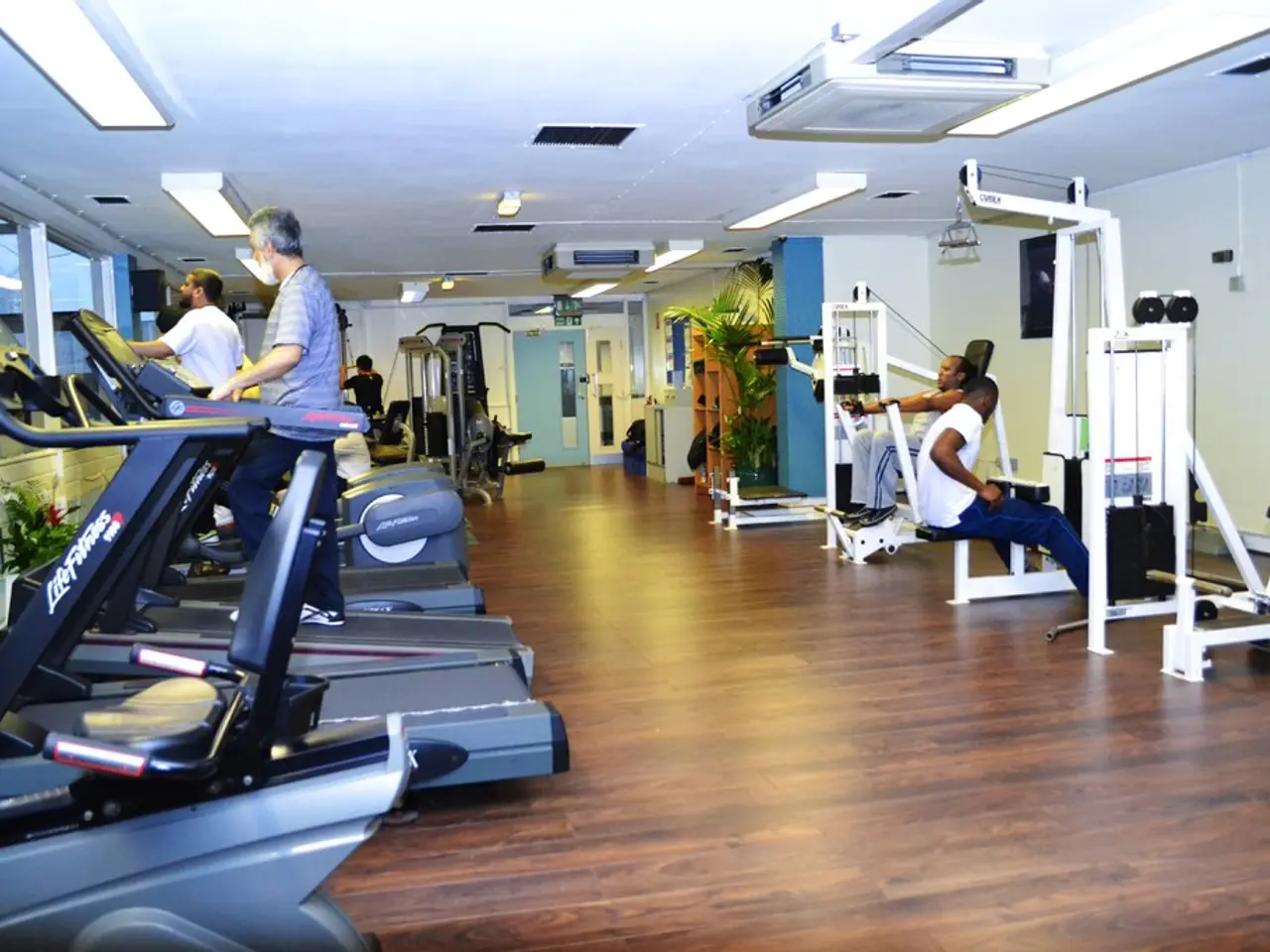Pulmonary Exercises: Methods and Advantages
Breathing exercises have gained popularity as a simple yet effective method for improving lung function and overall health. These exercises can help manage symptoms of various lung conditions, strengthen respiratory muscles, and enhance the quality of life for those affected.
Strengthening Respiratory Muscles
One common breathing exercise is diaphragmatic breathing, also known as belly breathing. This exercise involves lying on the back, placing hands on the stomach, closing the lips, and placing the tongue on the roof of the mouth. Inhale deeply through the nose, expanding the stomach, and repeat deep breaths for one minute [1]. This exercise helps strengthen the diaphragm, improving efficiency in breathing and potentially lowering heart rate [1].
Reducing Breathlessness
Pursed-lip breathing is another popular exercise that can help keep airways open for longer, allowing more air to flow in and out of the lungs. This technique is especially helpful for individuals with Chronic Obstructive Pulmonary Disease (COPD) as it slows exhalation and reduces shortness of breath [1][5].
Improving Lung Capacity and Airflow
Certain exercises promote increased lung capacity and better peak flow measurements, aiding conditions such as asthma and COPD. For example, the active cycle of breathing techniques (ACBT) is a chest physiotherapy technique that combines breathing control and coughing, helping to clear mucus and improve breathing ease [4].
Reducing Anxiety and Improving Relaxation
Mindfulness-based breathing techniques can activate the parasympathetic nervous system, easing anxiety and improving respiratory function. This is beneficial for asthma and COPD management [3][2]. Additionally, methods emphasizing nasal breathing, such as the Buteyko method, may reduce nighttime asthma symptoms by humidifying and filtering air [2].
Common Types of Breathing Exercises
- Diaphragmatic (Belly) Breathing: Strengthens the diaphragm, lowers heart rate, and reduces breathlessness [1][5].
- Pursed-Lip Breathing: Keeps airways open longer, reducing dyspnea, and improving breathing control [1][5].
- Buteyko Method: Reduces symptoms, reliance on medication, and prevents asthma attacks [2].
- Active Cycle of Breathing Technique (ACBT): A chest physiotherapy technique that helps clear mucus from airways [4].
- Box Breathing (4-4-4-4): Improves CO₂ tolerance, focus, and stress management [1][3].
- Inspiratory Muscle Training (IMT): Enhances inspiratory strength and improves lung function [1].
- Mindfulness Breathing Techniques: Reduces stress, anxiety, and improves mood and respiratory function [3].
Implementation Tips
- Regular practice is key to achieving benefits. Aim for 2–3 sessions daily for 5–10 minutes [1][5].
- Start with simpler techniques like diaphragmatic breathing and pursed-lip breathing before progressing to advanced methods or devices [1].
- Use chest physiotherapy techniques alongside breathing exercises to help clear mucus for pneumonia or chronic conditions with secretion issues [4].
- Incorporate mindfulness or relaxation breathing to address breathing-related anxiety common in chronic lung disease [3].
- Consult healthcare professionals or physiotherapists for personalized instruction, especially in cases of pneumonia or complex chronic lung disease [4].
Lung exercises are not only beneficial for those with lung conditions but can also be a calming and effective way to reduce stress levels. Singing may even benefit individuals wanting to improve their lung health, as it encourages slow, deep breathing, improves breath control, and helps use abdominal muscles effectively for singing and breathing [6].
References:
[1] American Lung Association. (2021). Breathing Exercises for Lung Health. Retrieved from https://www.lung.org/lung-health-and-diseases/lung-disease-lookup/copd/resources/breathing-exercises-for-lung-health
[2] Buteyko Clinic International. (n.d.). The Buteyko Method. Retrieved from https://www.buteykoclinic.com/buteyko-method/
[3] National Heart, Lung, and Blood Institute. (2019). Mindfulness-Based Stress Reduction for Chronic Lung Disease. Retrieved from https://www.nhlbi.nih.gov/health-topics/mindfulness-based-stress-reduction-chronic-lung-disease
[4] National Jewish Health. (2021). Active Cycle of Breathing Techniques (ACBT). Retrieved from https://www.nationaljewish.org/healthcare/treatments/lung-health/active-cycle-of-breathing-techniques
[5] National Institutes of Health. (2019). Pulmonary Rehabilitation. Retrieved from https://www.ncbi.nlm.nih.gov/books/NBK441949/
[6] The Mayo Clinic. (2021). Singing for Health. Retrieved from https://www.mayoclinic.org/healthy-lifestyle/singing/in-depth/singing/art-20048080
- Proper respiratory system health is vital in managing other respiratory conditions such as chronic obstructive pulmonary disease (COPD) and asthma, and even in preventing chronic kidney disease, type 2 diabetes, and certain types of cancer.
- In the realm of workplace-wellness, promoting respiratory health becomes increasingly important due to the high prevalence of respiratory-related medical conditions and chronic diseases.
- Understanding the science behind respiratory health can lead to the development of effective workplace-wellness programs that emphasize fitness-and-exercise, mental-health, eye-health, hearing, skin-care, cardiovascular-health, and Medicare benefits for employees.
- Pulmonary rehabilitation programs, often covered by Medicare, can equip individuals affected by respiratory conditions such as COPD with tools and knowledge to manage their diseases effectively.
- Advances in science have led to the discovery of novel treatments for respiratory conditions like COPD, which may include therapies-and-treatments such as CBD oil and medications.
- Rheumatoid arthritis, a chronic inflammatory disorder affecting the joints, can sometimes overlap with respiratory conditions, leading to additional management challenges.
- Skin conditions may arise as a result of certain treatments for respiratory diseases, emphasizing the need for comprehensive patient care that accounts for both respiratory health and skin care.
- Pursed-lip breathing, a simple breathing exercise, can help alleviate symptoms of respiratory conditions like COPD, although it may also be beneficial in managing stress.
- The Buteyko method, a breathing technique focused on nasal breathing, can not only help manage symptoms of asthma but also reduce the reliance on medication and potentially prevent asthma attacks.
- Mindfulness-based breathing techniques can provide mental health benefits by reducing stress, anxiety, and improving overall mood.
- Advanced breathing exercises like Inspiratory Muscle Training (IMT) can enhance the strength of respiratory muscles, thereby improving lung function and increasing aerobic exercise capacity.
- A combination of breathing exercises and chest physiotherapy techniques can help individuals with pneumonia or chronic conditions like COPD by improving lung capacity, reducing mucus, and alleviating respiratory symptoms.
- Regular practice of breathing exercises can contribute to overall health-and-wellness by improving lung function, reducing stress levels, and fostering better mental, cardiovascular, and skin health.







